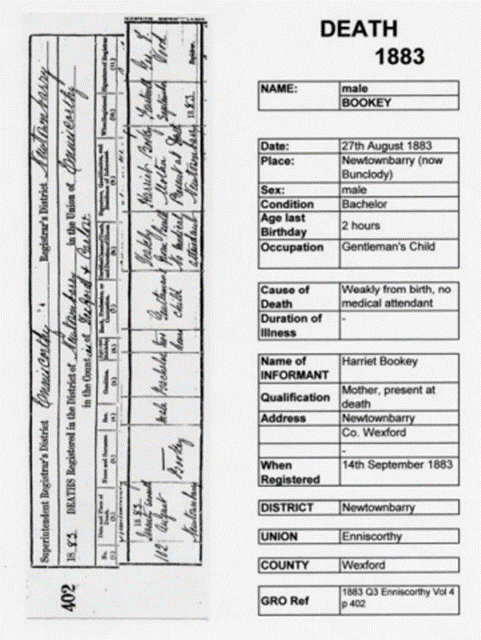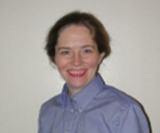The Perceptions of Pregnancy blog, like the Researchers’ Network, aims to reach beyond boundaries and borders, and to facilitate an international and interdisciplinary conversation on pregnancy and its associated bodily and emotional experiences from the earliest times to the present day. This week Kim Burkhardt explores her great-great grandmother’s experiences of birth in rural Ireland.
Harriet Susannah Ellis – the fifth of twelve children (plus an older half-sister from her father’s first marriage) – was born February 5, 1863 in Co. Sligo, Ireland. Her family moved around Ireland – seemingly possible due to the country’s new railroad system – as her father transferred from one teaching job to another. Her family moved to Co. Wicklow, south of Dublin, when she was seven.
Harriet and James Chartres Bookey went to Dublin from rural Ireland (from Co. Wicklow) to get married on September 5, 1882. Both were the children of professionals; Harriet’s father was a school master; James’ father was a doctor. Their fathers had served together on the parish vestry in their Church of Ireland parish in County Wicklow in 1870. Her parents and many of her siblings had left Co. Wicklow – due to her father’s next job transfer – prior to her marriage. She and an older sister had remained in Co. Wicklow (she was a teenager when her father accepted his next job).
After their apparent “elopement trip” to Dublin, Harriet and James returned to briefly to Co. Wicklow, then lived in the tri-county area of Counties Wicklow, Wexford, and Carlow until emigrating to North America in 1913. Four of their older surviving children – adults, by this time – emigrated ahead of them, one at a time. Harriet and James – with another five of their ten surviving children (still children) – then followed the first four emigrants to Vancouver, Canada.
Ireland’s 1911 census records indicate that Harriet had thirteen pregnancies, with ten surviving children. Genealogical research uncovered birth certificates for twelve of her children (information presented in the chart below created for her descendant’s genealogy book). Given that registering stillbirths in Ireland didn’t start until 1995 (it is still optional), it’s uncertain whether the thirteenth birth certificate simply wasn’t found or if that pregnancy involved a miscarriage or a stillbirth.
All of her children were born at home. For the twelve birth certificates identified, midwives were present for all but the first three births. The midwives who attended the births of Harriet’s later children – and who then submitted birth certificates for those children – spelled Harriet’s name in a variety of ways (see chart).
Harriet was twenty years old when she gave birth to her first child in Co. Wexford, eleven-and-a half months after getting married. It was an unattended home birth. The child – a male who wasn’t named – only lived two hours. In what must have been devastating for Harriet following this unattended birth in her first year of marriage, Harriet herself completed both the child’s birth certificate and the child’s death certificate, reporting that the child was “weakly from birth, no medical attendant.” This first child’s birth and death records are shown below:
When genealogy was underway, we pondered whether a medical attendant at the birth might have been able to save this child; if, for example, a midwife had been present or if her father-in-law – a doctor (and, by this time, the husband of Harriet’s older sister) – had been present at the birth.
Harriet gave birth every one to three years over the course of twenty years. When one of the youngest children was born, it was born late in the evening when the other children had already gone to bed. The midwife brought the newborn into a bedroom of some of the children, asking those children if they wanted to meet their new sibling; one sibling, named Florence (who recalled this story when she was a centenarian), recalled that she and her siblings all shouted “NO!” and they pulled their blankets over their heads! Given that her last child was born twenty years after her first child…and her last child was home until adulthood, Harriet ultimately spent forty years raising children. Harriet’s husband – who was seven years older than her – died in 1919 in Vancouver when their youngest child was sixteen, so Harriet finish raising children as a widow.
Harriet had come from a large family; she was the fifth of twelve children (plus an older half-sister from her father’s first marriage); her husband James was the youngest of eleven children. She mirrored this pattern having thirteen children, ten of whom lived (two of the children who died did so in their first three months of life, we don’t know whether the third was alive at birth). Harriet and James’ siblings, however, did not have large families. Five of Hariet’s siblings had no children, one sibling had children but we don’t know how many, one sibling had four children, two siblings had five children each. Thus, Harriet’s large brood was an outlier among her siblings.
Kim Burkhardt, M.B.A is one of Harriet’s great-great granddaughters. She co-wrote Harriet’s biography (2016) with Brian Ellis, Brian Ellis being a grandson of Harriet’s youngest brother. The full biography tells the story of her, including more about her experience of raising children. Her biography can be ordered online at https://harrietsusannahellis.wordpress.com/. She is now writing the biographies of all four of her maternal great-great grandmothers. These for great-great grandmothers were born in the 1840s – 1860s – one born in Ireland, one born in Canada, two born in the United States. Three of these women became widows while still raising children, the fourth died of Tuberculosis – thus leaving her husband a widower with children still at home; in no cases did these widow/widower spouses remarry until after their children were grown (Harriet was the only one to remarry at all; she remarried at the age of seventy-one). (see: https://womenofyesteryear.com/ )


